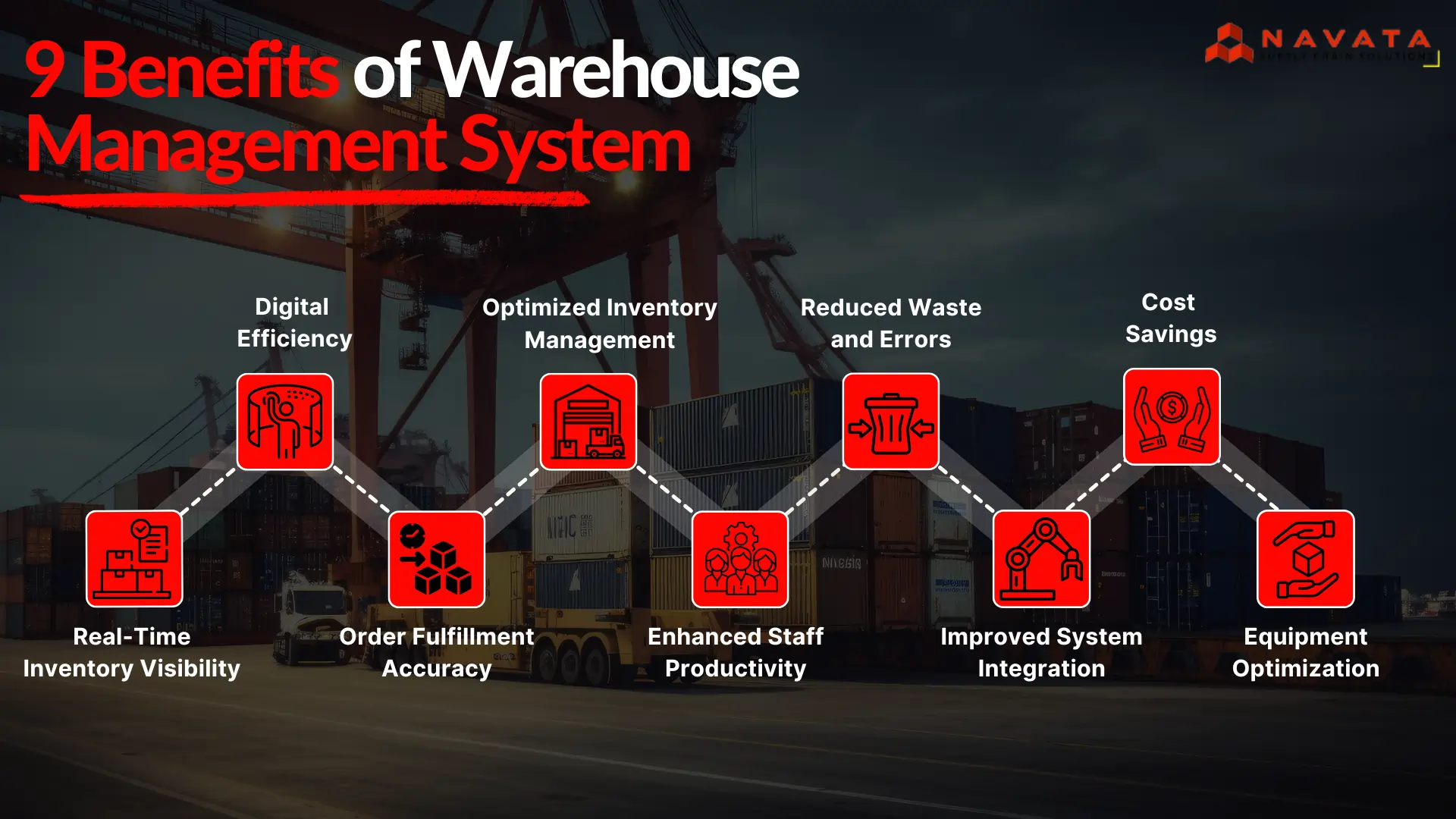Benefits of Warehouse Management System
Efficient warehouse management is the foundation of a successful supply chain, ensuring that products are properly stored, managed, and dispatched. With the rising complexity of logistics and consumer demands, businesses want a reliable solution to streamline their operations. This is where a Warehouse Management System comes in handy.
A warehouse management system is a software solution that helps to manage and optimize warehouses or distribution centers. It includes solutions for controlling inventory, streamlining operations, and increasing overall operational efficiency.
Manufacturers, retailers, and other organizations that need to keep track of what’s going on in warehouses and other facilities might greatly benefit from adopting a warehouse management system (WMS). These technologies can aid you in a variety of ways, including obtaining visibility into your inventory levels and optimizing the warehouse stocking process. As a result, organizations may run more efficiently, which benefits employees, customers, and the bottom line.
In this blog, we will look at the benefits of Warehouse Management System and how it may improve your warehouse operations.

Real-Time Inventory Visibility
A Warehouse Management System (WMS) often features real-time inventory tracking, which keeps staff up to date on stock levels and warehouse locations. This feature helps to prevent stockouts by keeping employees informed about what is available at all times. Employees can tell exactly when an item is getting low and place orders in real time to refill inventory before it runs out.
This timely reordering procedure ensures that storage facilities have adequate inventory levels, lowering the risk of shortages and allowing for smooth operations. Furthermore, accurate, real-time data enables better decision-making and planning, increasing supply chain efficiency.
Digital Efficiency
Keeping records on paper and in files is a time-consuming task that costs space. Through WMS, warehouse data and reports can be digitally saved on a remote location server or cloud-based storage for the same reason. It allows employees to generate a backup of inventory, sales, billing, and other data that can be referred to at any time in the future.
Also, this information can be used for re-warehousing, slotting, and other activities around warehouse space utilization.
Order Fulfillment Accuracy
A Warehouse Management System (WMS) enhances order accuracy by offering real-time visibility into stock levels. This ensures that employees always receive precise information about what is available in the warehouse, lowering the likelihood of selling things that are no longer in stock. With up-to-date stock data, the system ensures that only available items are presented for sale, reducing customer unhappiness due to out-of-stock circumstances.
A WMS also helps to prevent order mix-ups throughout the fulfillment process. The exact tracking of things and orders guarantees that the correct products are picked, packed, and dispatched to the relevant clients. This decreases the likelihood of sending incorrect items to clients, increasing total order accuracy and customer happiness.
Optimized Inventory Management
A Warehouse Management System (WMS) optimizes inventory levels by providing exact, real-time stock data. This reliable information enables timely replenishment, ensuring that items are reordered before they run out. A WMS detects concerns such as overstocking by monitoring inventory levels. When overstocking is discovered, corrective actions can be done, such as lowering future order levels or moving excess inventory to other facilities where it may be required more.
This optimum stock management guarantees that the appropriate amount of merchandise is always available. It eliminates the dangers of overstocking, which wastes resources and increases storage expenses, as well as stockouts, which create delays and lost sales. Overall, a WMS helps maintain a balanced inventory while enhancing efficiency.
Enhanced Staff Productivity
A Warehouse Management System (WMS) boosts employee productivity by adding tools such as warehouse scanning systems and automatic stocking instructions. These characteristics optimize numerous warehouse procedures, making them faster and more accurate.
Warehouse scanning technologies enable employees to immediately log orders as they arrive. Instead of manually documenting each item, personnel can use scanners to immediately update the system, saving time and effort. This results in more efficient order processing and reduces the possibility of errors.
WMS tools offer automatic stocking directions. WMS employs adjustable put-away algorithms to optimize item placement throughout the warehouse. These algorithms use characteristics including item velocity, volume, fragility, and temperature to select the ideal location for each item. This not only speeds up the stocking process but also guarantees that goods are stored in the most efficient and space-saving manner possible.
Optimize Your Warehouse Operations!
Reduced Waste and Errors
A Warehouse Management System (WMS) facilitates effective stocking and inventory management, which helps to reduce waste. One key benefit is reducing perishable item spoiling by good handling, such as maintaining optimal temperatures throughout storage. This keeps things such as food and medicines from expiring prematurely, retaining their quality and usefulness.
WMS enables employees to use a first-in, first-out (FIFO) inventory strategy, in which older items are despatched before fresh ones. Prioritizing the usage of older stock considerably reduces the risk of expiration-related waste. This proactive management approach not only increases operational efficiency but also promotes sustainable practices by reducing unnecessary waste generation.
Improved System Integration
Integrating a Warehouse Management System (WMS) with complementary systems such as Transportation Management Systems (TMS) and Enterprise Resource Planning (ERP) systems creates a holistic operational ecosystem. This linked method delivers a consolidated perspective on inventory, shipment information, and financial data, improving procedures and enhancing decision-making throughout the supply chain.
By seamlessly linking WMS with TMS and ERP systems, you can obtain real-time insights into inventory levels, shipping status, and overall financial health. This integration not only fosters higher accuracy in data management but also facilitates informed decision-making by offering a comprehensive perspective of operations. Employees can optimize resource allocation, reduce operational expenses, and improve customer happiness by guaranteeing timely and efficient order fulfillment.
Cost Savings
Implementing a Warehouse Management System (WMS) isn’t only about enhancing operations; it’s also about saving money. One way it does this is by cutting down on waste and errors. Imagine a scenario where a corporation orders too much of a product and it ends up sitting in the warehouse, unsold and eventually going to waste. That’s money down the drain. With a WMS in place, organizations can better track their inventory, so they know exactly what they have and what they need. This means they’re less likely to over-order or under-order, eliminating waste and saving money.
A WMS also helps organizations prevent costly shipping problems. Say a customer ordered something, but it gets shipped to the wrong address or comes late. This is not only inconvenience for customer, but it also costs the company money to remedy the mistake, whether it’s reshipping the goods or issuing refunds. With a WMS coordinating shipping and logistics, these errors are eliminated, saving both time and money.
Equipment Optimization
Forklifts, trucks, pallet jacks, and carts are all critical pieces of warehouse equipment for efficiently transferring items. However, the repetitive nature of warehouse activities causes severe wear and strain on this equipment, shortening its lifespan. Inefficient stocking, picking, and resetting operations can exacerbate the wear and tear, resulting in increased maintenance costs and more frequent equipment replacements.
Implementing a Warehouse Management System (WMS) can help to address these issues while also improving equipment utilization efficiency. WMS can generate more effective picking routes, reducing travel time and distance for forklifts and other equipment. By combining orders and categorizing them based on their proximity to one another, the WMS allows equipment operators to execute their tasks more rapidly and with fewer unnecessary moves.
You May Also Like Reading: Advanced Warehousing Technologies: 5 Latest Trends

Conclusion
A Warehouse Management System (WMS) provides various features that helps managing supply chains more efficiently. A WMS improves operational performance by offering real-time inventory tracking, digital records for efficiency, and increased order accuracy, all while decreasing errors and waste. A WMS also saves organizations time and money by optimizing inventory levels and improving staff efficiency using tools such as warehouse scanning systems.
Integration with related systems such as Transportation Management Systems (TMS) and Enterprise Resource Planning (ERP) systems helps to streamline operations and improve decision-making throughout the supply chain.Most importantly, a WMS saves money by reducing waste, avoiding costly shipping errors, and increasing the longevity and efficiency of warehouse equipment. Overall, implementing a WMS is a strategic investment that not only enhances warehouse operations but also helps succeed and survive in today’s competitive market.
Thanks For Reading: Benefits of Warehouse Management System
Powered By 360Presence
FAQ
What is a Warehouse Management System (WMS)?
A Warehouse Management System (WMS) is a software solution that helps manage and optimize warehouse operations. It benefits businesses by providing real-time inventory visibility, improving order fulfillment accuracy, optimizing inventory management, enhancing staff productivity, and reducing waste and errors.
What is the main purpose of warehouse management system?
The purpose includes overseeing the movement and storage of goods and materials from the moment they enter a distribution or fulfillment center until they leave. A WMS streamlines processes such as inventory tracking, order fulfillment, and storage optimization, ensuring that warehouse operations run smoothly and effectively.
What are the latest trend in WMS?
The latest trend in WMS is the integration of advanced technologies like artificial intelligence (AI), machine learning, and the Internet of Things (IoT) to enhance real-time data analytics, predictive maintenance, and automated decision-making, significantly improving warehouse efficiency and accuracy.
How does WMS provide real-time inventory visibility and why is it important?
WMS provides real-time inventory visibility by tracking stock levels and warehouse locations continuously. This feature is crucial. It helps prevent stockouts and overstock situations. Allowing staff to monitor inventory levels accurately. With real-time data businesses can make informed decisions. Plan better and ensure smooth operations. Ultimately enhancing supply chain efficiency
What are the benefits of having a warehouse management system?
A Warehouse Management System enhances inventory accuracy, boosts order fulfillment efficiency, optimizes storage space, reduces operational costs, increases staff productivity, and provides real-time data for better decision-making and supply chain management.

